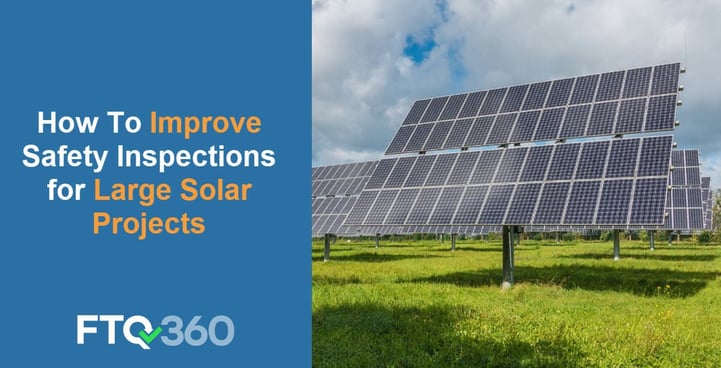
Large-scale solar projects typically involve the installation of thousands of photovoltaic (PV) panels on land or rooftops and can range from a few megawatts to thousands of megawatts (GW) in power output.
Given the colossal size and cost associated with a large-scale solar power plant, it is critical that the highest levels of safety and quality standards are adhered to. To ensure that all aspects of the project, from design to construction work, to operation and maintenance are conducted safely. And not just the once, regular safety inspections should be carried out throughout all stages of the project life cycle.
Safety Issues to Consider at Large Solar Power Plants
Solar power plants can pose various safety issues for workers, wildlife, and nearby communities. Because safety inspections focus on project-specific risks it is important to properly evaluate risks that need to be addressed. Safety inspections for large solar power plants involve a thorough review of the project design, construction work process, and the operation of the solar park to identify any safety risks that may be present. Some of the common safety issues are:
- Falls from high rooftops: Workers installing or maintaining solar panels on rooftops or high canopies can fall and suffer serious injuries or death. Proper fall protection equipment and training are essential to prevent this risk.
- Electrocution or other electric hazards: Solar farm workers handling panels, inverters, wiring, and other electrical components can be exposed to high voltage currents that can cause shocks, burns, or fires. Proper grounding, insulation, lockout procedures, and personal protective equipment are necessary to avoid this risk.
- Repetitive stress injuries: Workers lifting, carrying, or installing heavy solar panels can experience musculoskeletal disorders such as back pain, sprains, or strains. Ergonomic practices such as using mechanical aids, rotating tasks, and taking breaks can help prevent this risk.
- Cuts or sprains: Workers using sharp tools such as saws, drills, or knives to cut or assemble solar power plant panels and equipment can suffer cuts or lacerations. Workers walking on uneven terrain or slippery surfaces on a solar farm can also slip or trip and sprain their ankles or wrists. Wearing gloves, boots, and other protective gear can help reduce this risk.
- Panel reflection: Solar panels can reflect sunlight and create glare that can affect the vision of pilots, drivers, or residents near a solar power plant. This can cause accidents or discomfort for them. As such, panels should be designed to minimize reflection and oriented away from sensitive receptors such as airports, roads, or homes.
- Cadmium toxicity: Some solar panels use cadmium telluride (CdTe) as a semiconductor material that is highly toxic and carcinogenic. Exposure to cadmium can cause lung, kidney, and liver damage or failure. In solar panels, cadmium is often combined with tellurium which forms a more stable compound than cadmium alone. However, there is still a potential risk of cadmium leakage during the manufacturing, transportation, installation, operation or disposal of solar panels. Proper handling, storage, and recycling is therefore required to prevent this risk.
- End-of-life waste: Solar panels have a lifespan of about 20 to 30 years after which they need to be replaced. The disposal of old panels can create a large amount of waste that contains hazardous materials such as lead, silicon tetrachloride, and cadmium. These materials can leach into the soil and water if not properly disposed of in landfills or incinerators. Recycling solar panels is possible but not widely practiced due to technical challenges and low economic incentives. Developing more efficient and sustainable ways of managing end-of-life solar panels is important to reduce their environmental impact.
How Safety Inspections Improve Safety
The inspectors should also be aware of any existing or potential hazards and take appropriate measures to mitigate them.
Safety inspections can help reduce the risk of injury, illness, or death by identifying and addressing hazards at solar energy generation plants before they become an issue. They also help ensure that all equipment is operating properly and that workers are following safety protocols. Regular inspections also provide project managers with an accurate picture of safety conditions at the project site and can be used to assess progress, identify areas for improvement, and implement corrective actions. They also help ensure compliance with applicable regulations and standards and industry best practices. A comprehensive inspection should include visual inspections of the site, equipment, and materials and documentation reviews of permits, records, manuals, and test results.
Improve Inspections with FTQ360 Inspection Software
FTQ360 inspection software is a cloud-based platform that streamlines safety inspections for large-scale renewable energy projects. It allows inspectors to easily capture data in real-time, ensure compliance with regulations and standards, and provide detailed reports that can be used to assess the safety of a project. The software also helps automate many of the labor-intensive tasks associated with safety inspections, such as data collection, documentation review, and report generation.
For more information about how FTQ360 inspection software can improve safety inspections for solar projects, try a free demo today.
![[FREE EBOOK] Five Core Digital QAQC Functions for Successful Energy Projects](https://no-cache.hubspot.com/cta/default/3353989/2330d6b5-fdab-4c20-b603-b943735f1d7a.png)